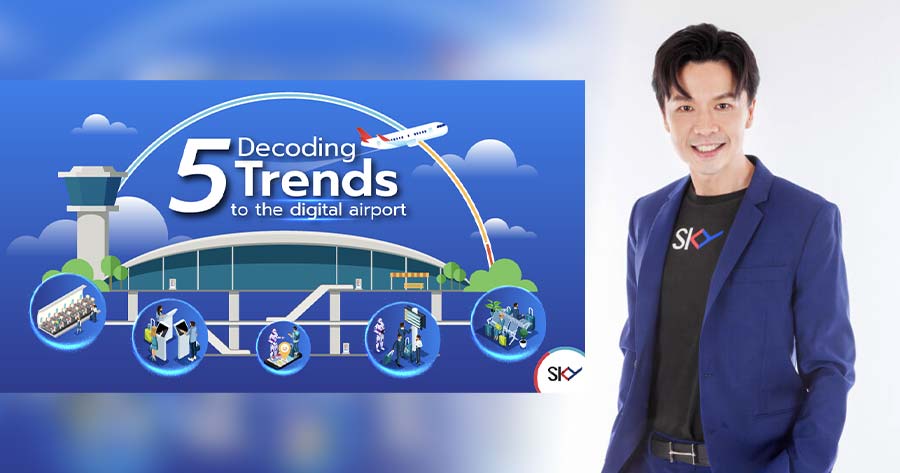The world’s airports and airlines are facing huge challenges, especially the changing needs of passengers after the tourism industry recovered rapidly. Thailand is one of the leading tourist destinations that must also prepare to deal with this big problem.
Kayon Tantichatiwat, Chief Marketing Officer, SKY ICT Public Company Limited or SKY said that SKY, as the leading tech company with expertise in aviation tech, is accelerating the study and development of technology that enhances airport service levels to deliver amazing travel experiences for travelers after getting off the plane. The airport industry around the world has brought technology to lift the service within the airport until new trends have been created in the last few years as follows:
1) Immersive Technology and Digital Twin
The phenomenon is that many businesses use immersive technology, both Augmented Reality (AR) and Virtual Reality (VR), to connect consumer experiences with various products and services. The airline company has also developed a platform to simulate the view and atmosphere inside the cabin to help passengers book tickets and make seat selection easier. In addition, the aviation industry uses digital twin technology to simulate structures from real objects and use sensors to help detect changes in real-time to help design and manufacture aircraft, including detecting and fixing various engineering systems inside the airport to increase safety and reduce the risk of system failure that will affect passenger travel time.
2) End-to-End Passenger Experience
The COVID-19 outbreak, which was declared a pandemic by World Health, affects people’s opportunities to make use of touchless technology. Nowadays, airports must simplify by bringing intelligent solutions to make passengers more convenient before, during, and after the flight, such as check-in kiosks, self-bag drop, and e-gates that use biometrics technology to scan your face, iris, or fingerprint to verify identity instead of a passport, which allows passengers to quickly check in and pass through immigration in seconds.
3) Integrated Digital Journey
Tourists, especially the younger generation, still want technology to help facilitate travel. Therefore, the airport industry must develop an app that allows passengers to manage every step through their smartphones 24 hours a day, such as flight reservation, check-in online, flight alerts, baggage tracking, inquiry service, and problem reporting in real-time. Some airports also use robotic navigation to help take passengers to various service points inside the airport precisely.
4) Passenger Flow Solutions
The return of tourism has caused many airports to experience overcrowding. To tackle the growth of passengers in airports worldwide, it is important to simulate and understand passenger flows to predict future capacity constraints and levels of service. Recently, some airports have developed smart robots using Artificial Intelligence (AI) to help analyze the number of passengers, solve congestion problems within the airport, and be ready to detect suspicious objects.
5) Sustainable Aviation
Sustainability is another major challenge for the aviation industry due to global warming. In addition, new-gen passengers pay more attention to the environment. Airports and airlines are trying to adapt their services to reduce carbon emissions. For example, the design of a passenger terminal reduces energy consumption by bringing in smart building systems to detect the operation of the heating and cooling control in the system. There is an indoor green area, solar panel system installation to reduce electricity consumption, renewable energy, and alternative fuels for aircraft, e.g. hydrogen fuel.
Kayon further explained that Thailand has continually developed the concept of the digital airport, especially Suvarnabhumi Airport, as the main airport of Thailand. To facilitate passengers and lift the next level of Thai airports, the airport has various intelligent technologies, such as the Common Use Passenger Processing System (CUPPS), and SAWASDEE by AOT application with many features that cover all travel needs.
At the same time, SKY’s tech team has collaborated with the ESIC Lab of the Computer Engineering department, the King Mongkut’s University of Technology Thonburi (KMUTT), connecting airport knowledge with digital technology to enhance the superior service with a variety of information resources in the airport. For example, analyzing passenger behavior in airport terminals, flight information, and passenger density estimation is to develop passenger experiences, services, and operations of officials under the principle of providing accurate and timely information to relevant parties. This is to maintain service standards to accommodate the expansion of the number of passengers and aim to become the airport of the future.





